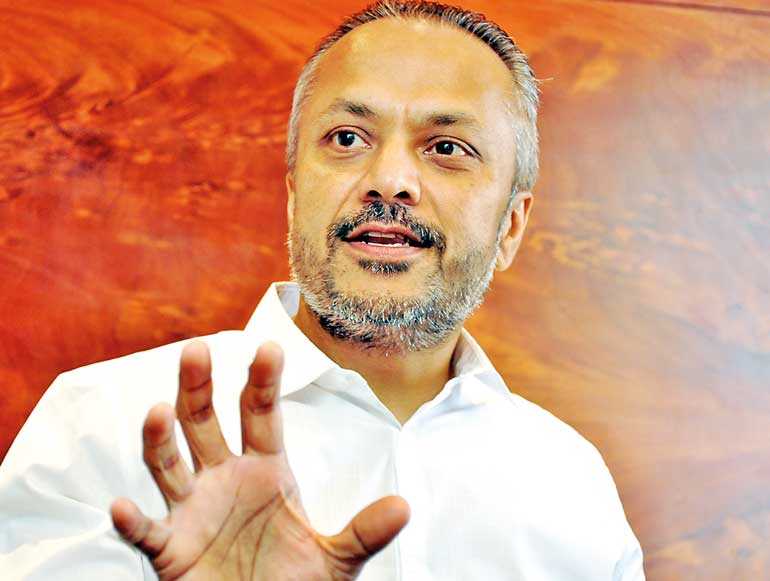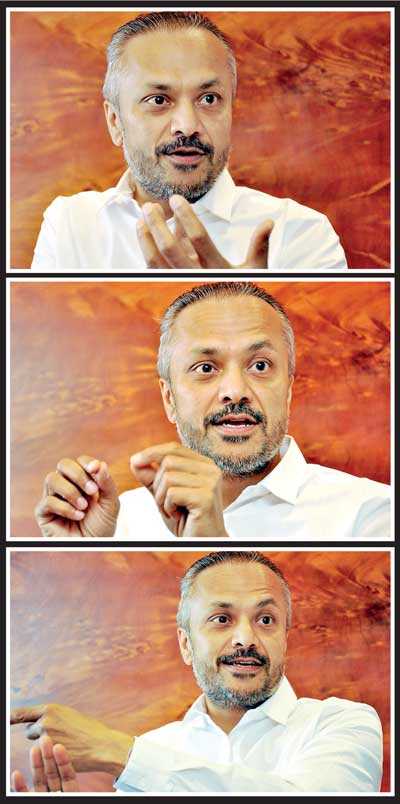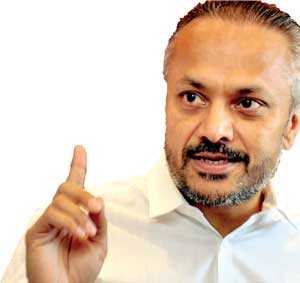Sunday Feb 23, 2025
Sunday Feb 23, 2025
Thursday, 7 June 2018 00:00 - - {{hitsCtrl.values.hits}}

Dharmesh Mistry, Chief Digital Officer at Temenos
By Madushka Balasuriya
When the Facebook-Cambridge Analytica data scandal broke earlier this year, the attention it grabbed in terms of wider public awareness shone a light on the range of possibilities surrounding big data and data analysis. With the personal data of millions of Facebook users in hand, Cambridge Analytica was alleged to have helped several politicians influence voter opinion ahead of US elections. This, while undoubtedly sinister, gave us some key insights into big data’s potential.
In modern times, big data is – or at least should be – part of every major industry. Sports moved into it very early, with concepts such as Moneyball taking baseball by storm, while online, several things that we now take for granted, such as accurate product recommendations on shopping websites, song pairing on YouTube, or even search queries on Google, are all down to the utilisation of vast amounts of personal data harvested on the internet.
And even so we’re still scratching the surface, because while the downside can seem downright nefarious – such as oddly specific targeted adverts – the upside has the makings of something truly avant-garde. Nowhere is this more evident than in the banking industry.
Enter Dharmesh Mistry, a British finance executive with a close eye on the future, whose overall focus lays on assisting largely traditional banks transform into “personalised lifestyle enablers” for each of their customers.
“A good digital banking service can make life better for everybody,” Mistry tells me during an exclusive sit down interview with Daily FT. “It can provide financial inclusion; If I have a more complex financial arrangement, it can make my life easier; I have to do less work to manage my finances, to reach my goals.”
Mistry was in Sri Lanka this past week in his capacity as Chief Digital Officer at Temenos, a global market leading software provider with over 2,000 bank customers around the world including 41 of the top 50 banks. Here, he hosted workshops titled, ‘The Digital Banking Journey: Road to Re-imagining Customer Experience’ with several heads of banks, the ultimate goal of which was to highlight the under-utilised nature of digital banking.
Open banking
Long thought of as simply a front-end banking service encompassing only things such as internet and mobile banking – services which basically provide a more convenient way of completing essential transactions, more often than not, accompanied by either a clunky mobile app or online portal – digital banking, Mistry believes, can be more than that. Much more.
“Why am I only interested in standing orders and direct debits? What about when my insurance is renewing? What about when my loan is expiring? What about when it comes to my birthdays, anniversaries, etc.?” he asks not completely rhetorically.
“When you focus on the customer and provide that extra value, that’s the differentiator now. Before, the front-end of banking was log on to the internet, see my products, pay some bills, etc. Now it might ‘get me the best financial product’, ‘get me the best interaction’, ‘make it easy to deal with my money’, ‘show me my total finances’. Now, many front-end banking services are emerging around open data and open banking.”
Open banking is a concept with data analytics at its heart, but one that has only recently begun to tread mainstream waters. The slow uptake is mainly down to the fact that it proposes an idea as far removed from the status quo as could be – banks openly sharing customer data with third parties (with the consent of the customer), including competing banks.
“[Data] was the thing that banks valued the most – we had customer data and it was used for financial services, based on their spending we knew much more about them – but now that information is available to other people,” he explains. “But as a result, what we will now see is a massive growth in distribution, new players just wanting to sell products, and consolidation of manufacturers.”
When I question Mistry as to the privacy concerns this may flag, especially following the recent media scrutiny on companies’ data collection habits, he offers a seasoned explanation and one that seems to hold some weight. Despite the leaks, he points out, people are still on Facebook – and there’s a reason for that.
“If the functionality and service is compelling they will turn a blind eye to it and they’ll give their data, but you have to give value back. This is the trick that banks have to learn,” he explains.
“Another thing that banks have the advantage with is that banks are trusted with the data. Irrespective of system outages, hacks, etc., banks are still trusted. Customers don’t really understand the full value of their data, but they know the value of their money, and banks have been trusted with that, so why not their data as well?
“Now they’re starting to learn that third parties such as Facebook are exploiting their data and that there’s some value to it. Things like GDPR as a regulation that enforces privacy is also starting to raise awareness of it, but it’s still going to take time for a majority of people to get it.”
Data-driven customer relations
Nevertheless, getting banks on board with this way of thinking is still a challenge, primarily because of how banks perceive the data they already have. They generally have the view that there is too much data for them to sift through, whereas Mistry proposes they start looking at it as not having enough. Customer stickiness – or loyalty – he says should be the ultimate goal.
“We have to find ways in banking where we create the customer stickiness through the data itself. A single transaction should have about 50-60 bits of information come through, not 4-5. What was the location? What was the weather? What was the time? Any other factor, what was the important thing in the news at the time? You might not know the purpose of storing all this stuff today, but keeping it in a data lake so that later on you can come back to it so that you can see how many people transferred money on the day X instance took place. Now is there anything in that group of people that we can look at to delve deeper so that we can find new niches? This is the point that data should generate more data. And more data just means better understanding.”
This ties in to Mistry’s core digital banking concept of it being an ‘end-to-end’ service. While banks have traditionally been strong on the manufacturing side of things (i.e. the creation of a banking product or service), this has always been somewhat separate from its distribution (i.e. the platform on which the service is available to public) arm.
For true digital banking optimal operational efficiency is a prerequisite, and that is something which can only be attained by striking the right balance between manufacturing and distribution.
“From a manufacturing aspect of it, you start to think about the lowest cost of transaction, volume, scale, etc. On the other hand we think about the customer, and we start to think about self-service, internet, mobile, customer lifecycle management, customer relationship management, etc.,” notes Mistry. “For digital banking you have to have both, it has to be end to end. We have to be operationally efficient so that we can innovate at the customer front-end side of things.”
Indeed, Mistry notes that new digital financial startups or financial technology (fintech) companies tend to operate at roughly half the cost of a traditional bank, which in turn enables them to spend significantly more of their capital on innovation – a key component of which is a customer-centric service.
In the past customer relations might have meant simply a personable bank manager, but now it means knowing the ins and outs of a customer’s life and providing them with services they might not ever realise they need. And open banking is crucial to this, in that it provides customers with an eco-system of products that they would not have access to otherwise. A single organisation cannot take on all of the innovation, asserts Mistry.
“In the UK we have 60 million people, but 4.5 million sole contractors – self employed people. Now we have 2-3 startup banks focusing on those 4-5 million customers. They not only provide the bank account but they’ll allow you to track your expenses because as a contractor that’s key, they allow you to issue invoices, they help you and allow you to file your tax return online – that’s key – and really what they’re doing is providing a set of services around the account that differentiates them from all of the other people.”
This is something, Mistry believes, even larger banks can tap into in terms of the rest of their customers’ needs, but they cannot do it alone.
“Ecosystems are definitely a powerful play for banks, but it doesn’t mean that every bank can have an ecosystem because it’s a really expensive process. You have to find the fintechs, you have to engage them, you have to validate them. And then you have to manage them afterwards.
“There are thousands of these players, so how do you manage that process? If you’re a big bank you can throw money at it where you create a hackathon, developer portal, etc. Even then you are limited in your scope in terms of how you foster the ecosystem.” This is where Temenos comes in with its self-service online digital marketplace which provides a showcase for both Temenos and a wider variety of fintech companies.
“Our approach is quite different, in that we will build the ecosystem because we have global reach, we have offices in over 50 countries, we have run in the last four years innovation jams in each of our regions. And what we do is we invite the fintechs in; per event we get 50-60 applicants, or we limit it, which means globally you’re getting 400-500 per year. Then we narrow that down to 15, create an event, and then invite the banks to see the innovation, which they want to see. And the fintechs want to see the banks too.
A confluence of technologies
Be that as it may, if you take Sri Lanka as an example, banks are quite comfortable in the way things stand. Relatively unchallenged, local banks have thus far failed to understand open banking and its possibilities. An attitude which can be largely attributed to a stubborn old guard that has seen previous digital harbingers of doom come and go, only to firmly remain atop their proverbial money tree.
“But things are fundamentally different now,” observes Mistry. “I did a mobile banking app for a bank in 1999. It was the first mobile banking app, but we told the CEO not to put too much money into it, as we had just proved the technology – it was just the R&D. He said, ‘no, this will revolutionise banking’ and I said, ‘no, it won’t’. Because it’s a poor experience, one graphic took two minutes to download, nobody wants to be kept waiting like that.
“It took another seven years before the App Store was launched, and the screen was better – it was touch – the graphics, the memory, the bandwidth, they were all better. This confluence of things happening is what made the iPhone work; it wasn’t because they were first, it was because a lot of these things matured at the right time.
“Now we see digital is being driven not by a single technology but by a confluence of multiple technologies. Cheaper hardware, better cloud services, better bandwidth, social media adoption, multiple technologies coming together at the right time is creating this disruption. That’s the thing that banks have to worry about.”
And while Mistry concedes that small fintechs may not necessarily eat away at a substantial share of the market, he warns there are definitely bigger fish lurking around the corner.
“You might have wonderful products but if somebody has got a better sales engine, better customer relationship management approach, they’re going to own the customer. So you might just end up then white-labelling your products to them. And although most of the revenue comes from manufacturing, most of the margin comes from distribution. This is why the big players are focusing on distribution. This is why Alibaba is much more of a threat than Google or Facebook.
“The threat is in multiple guises. I talk about the sharks and the piranhas. The piranhas are the fintechs that innovate around a specific product. They take little bites, but if there are enough of them you’re going to lose quite a significant share, as every little 5% adds up. Meanwhile your Alibabas and so on are probably going to take bigger chunks; they’re going to want to own the complete relationship from a commerce perspective as well as a banking perspective.”
Revised recruitment policies
That said, even though the mindset of big banks is thought to be gradually changing in certain quarters, by and large, there is still no clear motivating factor either in terms of profit or self-preservation to affect meaningful change; even the threat of digital startups scaling up is diminished by the inevitable drop in operational efficiency to follow, which will eventually see bigger banks scale back as needed to catch up.
“It’s a race to the middle,” reflects Mistry. He then shares an anecdote on why Tesla founder Elon Musk famously sold his shares in Paypal before venturing into space travel with SpaceX, setting up the punchline: “He actually thought it was easier to put somebody on Mars than to go into banking.”
“When we do think about these new players and whether they want to get into banking, it’s not that straight forward necessarily.”
Therefore, the only meaningful way to change this pattern of behaviour is to change the players itself. And as it is as already been established that new startups are unable to force traditional banks to change in the long run, the only option left available is to change those working at the banks from the ground up.
It only stands to reason that a more digital focus will involve the recruitment of individuals with an alternate set of skills to those from the old guard. That means looking beyond a degree in finance, says Mistry, or even someone well versed in computer programming.
“Where everyone says that banks need to be technology companies, I disagree. I think technology creates a level playing field. Technology is not a differentiator when you get a good platform that everyone can have.
“When it comes to competition it’s got to be about customer relationship, the product and the services that banks provide, how they attack a particular segment, that’s real business strategy. So then you start to think of the new skills needed.
“I need to understand customer behaviour, online targeting segmentation; it’s all about the data. I think in the future we should be hiring more people that specialise around understanding data. Data science, data analytics, all those skills are going to be much more valuable to banks than potentially writing code.”
So how much time does that realistically provide traditional banks before they start to worry? Mistry is unequivocal in his response.
“To quote Bill Gates ‘we overestimate the change that will happen in the next two years, and we underestimate the changes that will happen in the next 10’. Change is definitely coming – it’s already here – the mass impact though will take a little bit longer. But we are seeing the roots of it now. Trying to do this in five years time will be too late.”
Pix by Lasantha Kumara
Discover Kapruka, the leading online shopping platform in Sri Lanka, where you can conveniently send Gifts and Flowers to your loved ones for any event including Valentine ’s Day. Explore a wide range of popular Shopping Categories on Kapruka, including Toys, Groceries, Electronics, Birthday Cakes, Fruits, Chocolates, Flower Bouquets, Clothing, Watches, Lingerie, Gift Sets and Jewellery. Also if you’re interested in selling with Kapruka, Partner Central by Kapruka is the best solution to start with. Moreover, through Kapruka Global Shop, you can also enjoy the convenience of purchasing products from renowned platforms like Amazon and eBay and have them delivered to Sri Lanka.
Discover Kapruka, the leading online shopping platform in Sri Lanka, where you can conveniently send Gifts and Flowers to your loved ones for any event including Valentine ’s Day. Explore a wide range of popular Shopping Categories on Kapruka, including Toys, Groceries, Electronics, Birthday Cakes, Fruits, Chocolates, Flower Bouquets, Clothing, Watches, Lingerie, Gift Sets and Jewellery. Also if you’re interested in selling with Kapruka, Partner Central by Kapruka is the best solution to start with. Moreover, through Kapruka Global Shop, you can also enjoy the convenience of purchasing products from renowned platforms like Amazon and eBay and have them delivered to Sri Lanka.